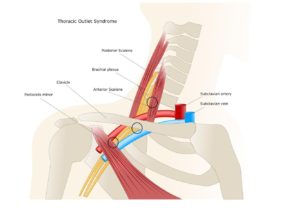 Do you ever experience pain or tightness in your neck and shoulder area and have numbness in your hand? Thoracic Outlet Syndrome could be the cause.
Do you ever experience pain or tightness in your neck and shoulder area and have numbness in your hand? Thoracic Outlet Syndrome could be the cause.
Your thoracic outlet is the space between your collar bone and 1st rib where blood vessels and nerves run through going down into your arm and hand.
Thoracic Outlet Syndrome is a result of these blood vessels or nerves being compressed in this space. There are different types of the syndrome – most commonly the nerves are compressed (98%) and less commonly (only 2%), the blood supply is compressed.
Anatomy of the Thoracic Outlet
Structures which are most commonly compressed:
- Subclavian artery
- Subclavian Vein
- Brachial plexus (bundle of nerves supplying the upper body and arms)
What causes this compression?
- Poor posture
- Rounding your shoulders and holding your head in a forward position can cause compression in the thoracic outlet area.
- Trauma
- Impact from a car accident or another traumatic event can cause changes that compress the nerves in the thoracic outlet. These symptoms are often delayed in relation to the event.
- Repetitive activity
- As we all know, doing the same movements over and over can wear out overworked parts of your body and leave you with tension in these areas. This can also be the case for thoracic outlet syndrome. Repetitive movements such as continuous typing at the computer, lifting things above your head or sports movements such as swimming and playing cricket can all lead to compression in the thoracic outlet area.
- Anatomical defects
- Inherited bony abnormalities that present at birth may include an extra rib at the top of your ribcage, which can lead to compression.
- Extra pressure on your joints
- Being overweight puts extra stress on your joints, as can carrying an oversized heavy backpack.
Risk Factors:
- Females more affected than males
- More common in young adults 20 – 40 years old
What are the symptoms?
The various forms of thoracic outlet syndrome present with varying symptoms, depending on which structures are being compressed.
Symptoms you may experience if your nerves are involved:
- Muscle wasting in the fleshy muscle at the base of your thumb
- Numbness/ tingling in your arm or fingers
- Pain into your neck, shoulder or hand
- Weakening grip
Symptoms you may experience if your blood supply is involved:
- Discolouration of your hand or loss of colour in fingers/hand
- Arm pain and swelling
- Weak or no pulse in affected arm
- Cold fingers, hands or arms
- Arms tire quickly with activity
Is there any treatment?
Physiotherapy can be very effective in managing Thoracic Outlet Syndrome. Here at Central Lakes Physio we can help you by:
- Releasing tight muscles around neck, shoulder and chest
- Posture advice and education
- Mobilising a tight thoracic spine and 1st rib
- Providing stretching, strengthening and nerve gliding exercises for shoulder and neck
- Ergonomic assessment – having your work place set up assessed
How can I prevent this syndrome?
- Avoid repeated movements and lifting heavy objects.
- Manage your weight if you are overweight
- Avoid carrying heavy bags over your shoulder
- Stretch daily
- Strengthen your shoulder and neck complex to keep strong and mobile
If you are experiencing any of the symptoms above, come and see us at Central Lakes Physio where we can assess, treat and advise you on how to best manage this condition! Prompt treatment is always best, as you may experience progressive nerve damage with ongoing compression.
You can book in online here.

